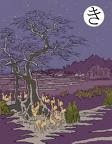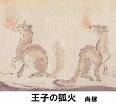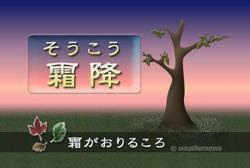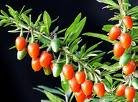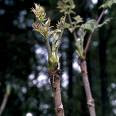[ . BACK to WORLDKIGO TOP . ]
::::::::::::::::::::::::::::::::::::::::::::::::::::::::::::::::::::::::::::::::::::::::::::::::::::
Barley, wheat (mugi)
***** Location: Japan
***** Season: various, see below
***** Category: Plant
*****************************
Explanation
There are various words corresponding to
MUGI.
wheat, "small mugi" komugi, 小麦
Triticum aestivum
barley, "large mugi", oomugi, 大麦
Hordeum vulgare
..... "naked mugi", hadaka mugi 裸麦
oats, "crow mugi", karasumugi 烏麦(からすむぎ)
Avena fatua
..... enbaku 燕麦(えんばく)
Job's tears; tear grass , "dove mugi", hatomugi
鳩麦(はとむぎ)
Coix lacryma-jobi
for more details see below

Let us look at some kigo.
:::::::::::::::::::::::::::::::::::::::::::::::::::::::::::::::::::::::::::::::::::::::::::::::::::
. . . . . SPRING
early spring
treading on barley/wheat fields, mugifumi 麦踏 (むぎふみ)
mugi o fumu 麦を踏む(むぎをふむ)
all spring
green barley/wheat, aomugi 青麦 (あおむぎ)
..... mugi aomu 麦青む(むぎあおむ)
:::::::::::::::::::::::::::::::::::::::::::::::::::::::::::::::::::::::::::::::::::::::::::::::::::
. . . . . SUMMER
The time when barley/wheat is ripe for the harvest is called "
autumn", in reference to the time when rice is ripe for harvest.
early summer
mugi 麦 (むぎ) Mugi
homugi 穂麦(ほむぎ)ears of Mugi
..... mugi no ho 麦の穂(むぎのほ)
karasumugi 烏麦(からすむぎ)oats
..... ootomugi オート麦(おーとむぎ)
..... suzume mugi 雀麦(すずめむぎ)"sparrow oats"
chahikigusa 茶挽草(ちゃひきぐさ)
komugi 小麦(こむぎ)
wheat
oomugi 大麦(おおむぎ)
barley
..... "naked mugi", hadaka mugi 裸麦
..... "skin mugi", kawamugi 皮麦(かわむぎ)
raimugi らいむぎ
rye, Gerste
..... kuromugi 黒麦(くろむぎ)"black mugi"
Secale cereale
mugibatake 麦畑(むぎばたけ)
mugi field
mugi u 麦生(むぎう)planted mugi
mugi no nami 麦の波(むぎのなみ)waves of mugi
yasemugi 痩麦(やせむぎ)thin, weakly mugi
wasemugi, wase mugi 早麦(わせむぎ) early mugi
.................................................................................
mugi no kuroho 麦の黒穂 (むぎのくろほ) black ears of mugi
from illness
..... kuroho 黒穂(くろほ) "black (grain) ears"
.................................................................................
"barley autumn", mugi no aki 麦の秋 (むぎのあき)
mugiaki 麦秋(むぎあき) bakushuu 麦秋(ばくしゅう)
"autumn wind on the barley/wheat fields" , mugi no akikaze
..... 麦の秋風 (むぎのあきかぜ)
storm on the barley/wheat, mugi arashi 麦嵐(むぎあらし)
rice with barley/wheat, mugimeshi 麦飯 (むぎめし)
plain barley/wheat cooked , sumugi すむぎ
harvesting barley/wheat 麦刈 ( むぎかり)
migi karu 麦刈る(むぎかる)
car transporting barley/wheat, mugiguruma 麦車(むぎぐるま)
threashing barley/wheat, mugikoki 麦扱 (むぎこき)
threashing maschine, mugikoki ki 麦扱機(むぎこきき)
 threashing barley/wheat, mugi uchi 麦打 (むぎうち)
threashing barley/wheat, mugi uchi 麦打 (むぎうち)
..... mugi tataki 麦叩(むぎたたき), mugi tsuki 麦つき(むぎつき)
..... mugi kachi 麦搗(むぎかち)
pole for threashing, mugi no karasao
麦の殻竿(むぎのからさお)
dust from threashing, mugi bokori 麦埃(むぎぼこり)
burning barley/wheat, mugiyaki 麦焼き(むぎやき)
barley/wheat straw, mugiwara 麦藁 (むぎわら)
..... mugiwara 麦稈(むぎわら)
new barley/wheat, shinmugi 新麦 (しんむぎ )
barley/wheat of this year, kotoshi mugi 今年麦(ことしむぎ)
............................................
all summer
 barley/wheat tea, mugiyu 麦湯 (むぎゆ)
mugicha
barley/wheat tea, mugiyu 麦湯 (むぎゆ)
mugicha 麦茶(むぎちゃ), mugicha hiayashi 麦茶冷し(むぎちゃひやし)
..... mugiyu hiyashi 麦湯冷し(むぎゆひやし)
"barley drink", beer, mugishu 麦酒(びーる)
:::::::::::::::::::::::::::::::::::::::::::::::::::::::::::::::::::::::::::::::::::::::::::::::::::
. . . . . AUTUMN
early autumn
hatomugi 鳩麦 (はとむぎ) Job's tears; tear grass,
..... hatomugi 川殻(はとむぎ)"dove mugi"
..... senkoku せんこく
juzudama 数珠玉 (じゅずだま) "rosary beads"
..... zuzuko ずずこ、toomugi 唐麦(とうむぎ)"Chinese wheat"
(sometimes placed in late autumn)
:::::::::::::::::::::::::::::::::::::::::::::::::::::::::::::::::::::::::::::::::::::::::::::::::::
. . . . . EARLY WINTER
mugi maki 麦蒔 (むぎまき) sowing wheat
:::::::::::::::::::::::::::::::::::::::::::::::::::::::::::::::::::::::::::::::::::::::::::::::::::
The Ministry of Agriculture, Forestry and Fisheries
distinguishes between these groups of MUGI
- - - yonbaku 四麦(よんばく) your types of mugi
komugi コムギ
oomugi オオムギの3変種 with three sub-groups
kawamugi カワムギ 皮麦、
hadaka mugi ハダカムギ
biiru mugi ビールムギ)
- - - sanbaku 三麦 three types of mugi
komugi コムギ
rokujoo oomugi 六条オオムギ
kawamugi カワムギ
hadakamugi ハダカムギ)
© More in the WIKIPEDIA !
The word komugi referes to the older spelling
ko mugi 古麦 "old mugi" or
komugi 粉麦 "mugo flour"
Since the Heian period,
komugi 小麦 was made into flour for noodles and
oomugi 大麦 was used as a grain like rice.
Since the Edo period, the word MUGI is usually used for oomugi 大麦 - barley.
小麦の日本での事情
source : www2.odn.ne.jp/shokuzai
*****************************
Worldwide use
*****************************
Things found on the way
the bride tosses
wheat grains over her shoulders –
sparrows flutter
Wheat grains or rice considered a symbol of prosperity and fertility.
The ritual of throwing wheat or rice signifies that the bride is paying back whatever parents have given her. In addition, it is as a gesture of wishing prosperity for the family she leaves behind.
This ritual is common among Hindus as well as Sikhs..
- Shared by Sandip Sital Chauhan -
Joys of Japan, September 2012
 Why is rice thrown at weddings?
Why is rice thrown at weddings?
Since early Roman times some grain - usually wheat - has been associated with the wedding ceremony.
source : trivia/explain
:::::::::::::::::::::::::::::::::::::::::::::::::::::::::::::::::::::::::::::::::::::::::::::::::::::::::::::::

hatomugi Daruma tea
and dokudami Daruma tea
どくだみ・はとむぎ ダルマ
*****************************
HAIKU
甲斐の山中に立ち寄りて
Staying at a lodging in Yamanaka, Kaii province
行く駒の麦に慰む宿り哉
ゆく駒の麥になぐさむやどり哉
yuku koma no mugi ni nagusamu yadori kana
行駒の麦に慰むやどり哉
iku koma no mugi ni nagusamu yadori kana
The horse carrying me
Enjoys eating the ears of
Barley while resting!
Tr. Oseko
This hokku has the cut marker KANA at the end of line 3. Written in 1685.
Kaii was famous for its black horses.
The kigo is "mugi no aki" 麦秋.
my brave horse
solaced with munching barley
from the lodging . . .
Tr. Gabi Greve
It is not too cold and not too warm to travel in the fourth lunar month. The horse is happy and Basho is looking forward to meet old friends soon. For now he is content watching his horse munching the barley and resting for the night somewhere "in the mountains" (yamanaka).
Basho is maybe close to Tsurushi town 都留市.
Or he is somewhere close to Lake Yamanaka 山中湖.
When is home in Edo had burned down in 1682, he had taken refuge for a while with a friend in Kaii and written two hokku about the famous horses.
馬ぼくぼく我を絵に見る夏野哉
馬ぼくぼく我を絵に見る心かな
uma hokuhoku ware o e ni miru natsu-no kana
uma bokuboku ware o e ni miru natsu no kana
I find myself in a picture
The cob ambles slowly
Across the summer moor.
Tr. Joan Giroux,
. WKD : Onomatopoetic words .
At Kaii, during
. Nozarashi Kiko 野ざらし紀行 .
. Matsuo Basho 松尾芭蕉 - Archives of the WKD .
::::::::::::::::::::::::::::::::::::::::::::::::::::::::::::::::::::::::::::::::::::::::::::::::::::
麦秋や本の秋より寒い雨
mugi aki ya hon no aki yori samui ame
autumn of the barley -
the rain is colder than
in real autumn
麦の葉は春のさま也なく千鳥
mugi no ha wa haru no sama nari naku chidori
the leaves of wheat
look just like spring -
plovers singing
Kobayashi Issa
Tr. Gabi Greve
*****************************
Related words
*****
Paddy, Fields, rice paddies (ta, hatake) Japan
*****
Buckwheat (soba)
. PLANTS IN SUMMER - SAIJIKI
:::::::::::::::::::::::::::::::::::::::::::::::::::::::::::::::::::::::::::::::::::::::::::::::::::




